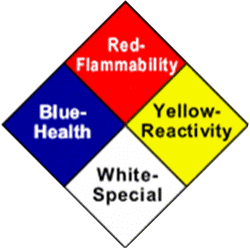

LAB SAFETY
Experiments are a great way to learn about science. Whether we are mixing up chemicals, examining fossils, or trying to grow plants, we must keep in mind safe practices in the lab. All students must be instructed in safe practices before doing any type of lab experiment.All students will be instructed in the following during class:
Emergency Exits
Use of Safety Equipment
Disposal of Chemicals
Accident Prevention
First Aid
Safety Symbols
These methods and procedures are also included in the safety contract that students and their parent must sign. Since science is a hands-on laboratory class, it is important that we follow all safety practices and report violations immediately. Students and their parents will be required to read the Flinn Safety Contract, sign and return a printed copy before that student performs any lab experiment.
MATERIALS SAFETY DATA SHEET (MSDS)
The MSDS is a sheet that gives specific physical and chemical properties about substances.Substances are categorized by these properties and labeled for safety. Below is the
National Fire Protection Agency Safety Diamond explained. On the MSDS, this diamond
identifies fast identification of hazardous materials such as chemicals in the laboratory.
| Health | ||
| 4 | Danger | May be fatal on short exposure. Specialized protective equipment required |
| 3 | Warning | Corrosive or toxic. Avoid skin contact or inhalation |
| 2 | Warning | May be harmful if inhaled or absorbed |
| 1 | Caution | May be irritating |
| 0 | No unusual hazard | |
| Flammability | ||
| 4 | Danger | Flammable gas or extremely flammable liquid |
| 3 | Warning | Flammable liquid flash point below 100° F |
| 2 | Caution | Combustible liquid flash point of 100° to 200° F |
| 1 | Combustible if heated | |
| 0 | Not combustible | |
| Reactivity | ||
| 4 | Danger | Explosive material at room temperature |
| 3 | Danger | May be explosive if shocked, heated under confinement or mixed with water |
| 2 | Warning | Unstable or may react violently if mixed with water |
| 1 | Caution | May react if heated or mixed with water but not violently |
| 0 | Stable | Not reactive when mixed with water |

| Special Notice Key | ||
| W | Water reactive | |
| Oxy | Oxidizing agent | |
SAFETY PRACTICE
Below are a group of safety icons commonly used in the lab.Place the cursor over the image to reveal its description.
 ANIMAL SAFETY
ANIMAL SAFETYTreat live animals with care to avoid harming the animals or yourself. Working with animal parts or preserved animals also may require caution. Wash your hands when you are finished with the activity.
 LAB APRON
LAB APRONWear a laboratory apron to protect your skin and clothing from damage.
 CORROSIVE MATERIAL
CORROSIVE MATERIALYou are working with an acid or another corrosive chemical. Avoid getting it on your skin or clothing, or in your eyes. Do not inhale the vapors. Wash your hands when you are finished with the activity.
 DISPOSAL
DISPOSALChemicals and other laboratory materials used in the activity must be disposed of safely. Follow the instructions from your teacher.
 FLAMES
FLAMESYou may be working with flames from a lab burner, candle, or matches. Tie back loose hair and clothing. Follow instructions from your teacher about lighting and extinguishing flames.
 FUMES
FUMESWhen poisonous or unpleasant vapors may be involved, work in a ventilated area. Avoid inhaling vapors directly. Only test an odor when directed to do so by your teacher, and use a wafting motion to direct the vapor toward your nose.
 HEAT RESISTANT GLOVES
HEAT RESISTANT GLOVESUse an oven mitt or other hand protection when handling hot materials. Hot plates, hot glassware, or hot water can cause burns. Do not touch hot objects with your bare hands.
 SAFETY GOGGLES
SAFETY GOGGLESAlways wear safety goggles to protect your eyes in any activity involving chemicals, flames or heating, or the possibility of broken glassware
 WASH HANDS
WASH HANDSWash your hands thoroughly when finished with the activity. Use antibacterial soap and warm water. Lather both sides of your hands and between your fingers. Rinse well.
 NO FLAMES
NO FLAMESFlammable materials may be present. Make sure there are no flames, sparks, or other exposed heat sources present.
 PLANT SAFETY
PLANT SAFETYHandle plants in the laboratory or during fieldwork only as directed by your teacher. If you are allergic to certain plants, tell your teacher before doing an activity in which those plants are used. Avoid touching harmful plants such as poison ivy, poison oak, or poison sumac, or plants with thorns. Wash your hands when you are finished with the activity.
 POISON
POISONDo not let any poisonous chemical come in contact with your skin, and do not inhale its vapors. Wash your hands when you are finished with the activity.
 SAFETY AWARENESS
SAFETY AWARENESSYou may see this symbol when none of the symbols described earlier appears. In this case, follow the specific instructions provided. You may also see this symbol when you are asked to develop your own procedure in a lab. Have your teacher approve your plan before you go further.
 SHARP OBJECTS
SHARP OBJECTSPointed-tip scissors, scalpels, knives, needles, pins, or tacks are sharp. They can cut or puncture your skin. Always direct a sharp edge or point away from yourself and others. Use sharp instruments only as instructed.
 ELECTRIC SHOCK
ELECTRIC SHOCKAvoid the possibility of electric shock. Never use electrical equipment around water, or when the equipment is wet or your hands are wet. Be sure cords are untangled and cannot trip anyone. Disconnect the equipment when it is not in use.
 PHYSICAL SAFETY
PHYSICAL SAFETYTreat live animals with care to avoid harming the animals or yourself. Working with animal parts or preserved animals also may require caution. Wash your hands when you are finished with the activity.
 BREAKABLE GLASSWARE
BREAKABLE GLASSWAREYou are working with materials that may be breakable, such as glass containers, glass tubing, thermometers, or funnels. Handle breakable materials with care. Do not touch broken glassware.
 HEATING
HEATINGUse a clamp or tongs to pick up hot glassware. Do not touch hot objects with your bare hands.